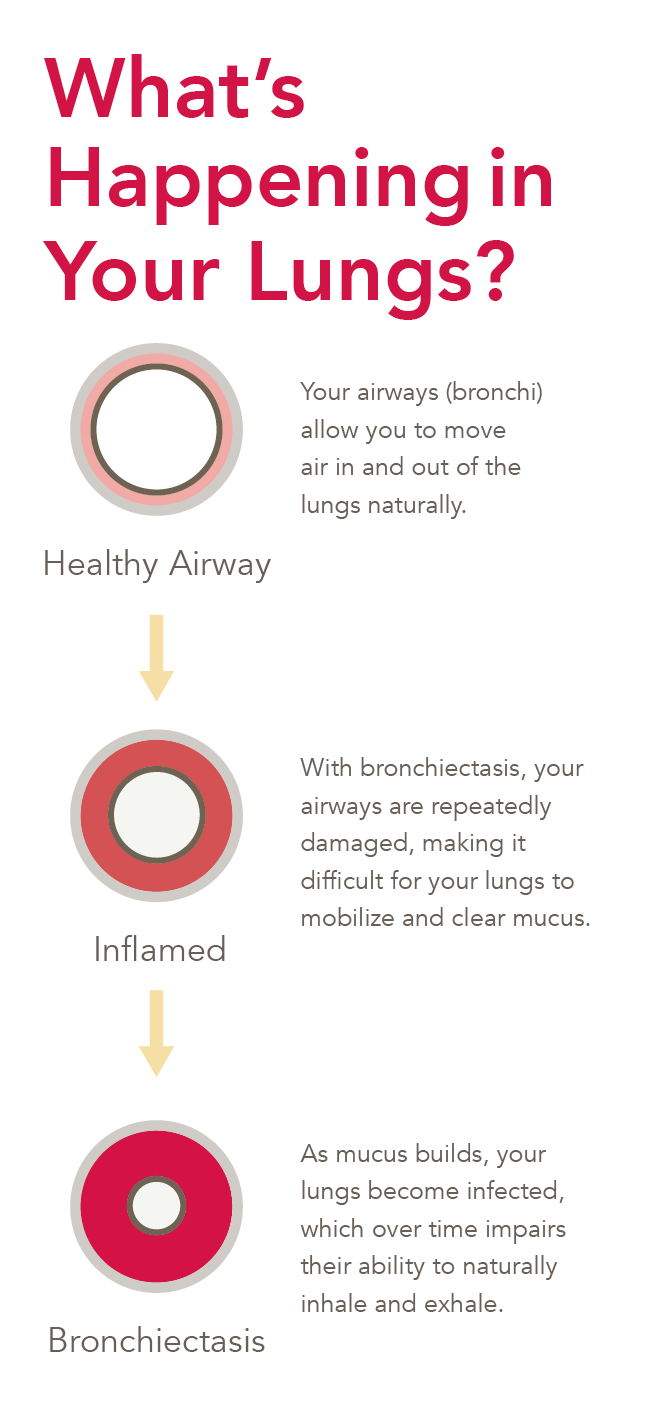
Receiving a medical diagnosis can often feel like a double-edged sword. On the one side, you’re relieved to finally put a name to the type of symptoms you’ve been experiencing and can start the next step of finding the right treatment to manage your condition.
On the other side, it’s now confirmed and can leave you with many questions, including:
- How will this condition affect my quality of life?
- What if I can’t do the things I love?
- How much will treatment cost?
- What if therapy doesn’t work?
If you’ve recently been diagnosed with bronchiectasis—a chronic lung condition that constricts the airways, making breathing more difficult—you’re not alone.
In fact, it’s estimated that up to 500,000 people living in the United States are experiencing bronchiectasis-like symptoms [1].
The only way to accurately diagnose this condition is with a high-resolution chest computerized tomography (HRCT) scan. If your clinician has confirmed your diagnosis using this method, you might be wondering how you developed bronchiectasis in the first place.
 What Is the Most Common Cause of Bronchiectasis?
What Is the Most Common Cause of Bronchiectasis?
There are many reasons for why a person can develop bronchiectasis, but the most common cause is repeated damage to your lungs and airways.
Every time you take a breath, air fills your lungs through a narrow passageway called the bronchial tubes (i.e., airways). When air is released back out from the lungs, it travels through this same passageway.
Damage to this area, due to infections, inflammation, or airway blockage [2], can cause your airways to widen overtime, making it more difficult for them to mobilize and clear mucus from the lungs:
“Bronchiectasis describes the condition when the airway walls (bronchi) become irreversibly thickened and damaged. As more walls become scarred, the bronchi are no longer able to effectively drain normal secretions, so mucus builds up and becomes a breeding ground for germs. This creates a vicious cycle of inflammation and infection that eventually forms irregular airway pockets, leading to loss of lung function over time” [3].
This definition from the American Lung Association helps answer another common question that many patients have about this condition, such as:
Is Bronchiectasis Contagious?
The answer is no, as bronchiectasis develops from repeated damage to the lungs and airways, which may be caused by another underlying condition that constricts the airways, such as cystic fibrosis or chronic obstructive pulmonary disease (COPD).
However, certain conditions that may be contagious, such as pneumonia or measles [4], can cause repeated cycles of infection that further damage your airways, putting you at greater risk of developing bronchiectasis-like symptoms.
A person cannot develop bronchiectasis simply because a close friend or loved one is living with it.
Other Causes of Bronchiectasis
Another reason you may have developed bronchiectasis is because your cilia (those tiny hair-like structures located along your bronchi tube) are damaged.
“In bronchiectasis, damage to the cilia in the bronchial tubes means they cannot sweep the particles and mucus upward. Instead, particles and mucus accumulate. The sputum becomes sticky and difficult to move, even with coughing…leading to [i]nfections, further damage, and more sputum,” [5].
Underlying conditions like cystic fibrosis and COPD can cause a person to develop bronchiectasis. However, these two chronic lung conditions can also co-exist with bronchiectasis. This is known as a comorbid condition.
Any chronic condition, whether hereditary or not, that constricts your lungs and airways causing mucus buildup and infection may be the culprit for why you’re living with bronchiectasis.
According to the American Lung Association, although we can decipher common causes of bronchiectasis, there are still around 40% of cases where the cause is unknown. This is referred to as idiopathic bronchiectasis [6].
Though the cause is unclear in some instances, the effects to your lungs and airways remain the same.
 I Have Bronchiectasis. Now What?
I Have Bronchiectasis. Now What?
Let’s review the first few questions circling your mind after you receive a bronchiectasis diagnosis:
How will this condition affect my quality of life?
Bronchiectasis can cause you to experience the following symptoms:
- Shortness of breath
- Repeated respiratory infections
- Chronic cough
- Excess mucus production
- Fatigue
- Tightness of chest
When symptoms are not managed regularly, you can experience what’s known as an exacerbation (i.e., a worsening of symptoms). When this happens, you may require certain medications or even hospitalization, depending on the severity of your symptoms.
This can make you feel anxious or upset, which brings us to another question you may have:
What if I can’t do the activities I love?
 It’s true that bronchiectasis can impact your quality of life, and if you’re having trouble breathing, you might worry about the types of activities you’ll miss doing.
It’s true that bronchiectasis can impact your quality of life, and if you’re having trouble breathing, you might worry about the types of activities you’ll miss doing.
With the right airway clearance therapy, you never need to live in fear of your condition or let it prevent you from pursuing your passions.
SmartVest, for example, a high frequency chest wall oscillation (HFCWO) therapy device, is designed to provide an airway clearance technique.
What this means is you’ll use a respiratory vest to deliver repeated pulses of air that gently squeeze and release the upper chest wall (giving you 360° chest coverage). This aids in your airways’ ability to propel mucus upward, where it’s more easily coughed out of the lungs.
Rather than worrying about how much treatment will cost, or whether you can afford it, you’ll be glad to know that SmartVest may be covered by private insurance carriers, Medicare, State Medical Assistance, and the U.S. Department of Veterans Affairs.
Does SmartVest Work?
 We invite you to request an information packet to learn more about SmartVest and how it works to help patients experience symptom relief from their chronic condition.
We invite you to request an information packet to learn more about SmartVest and how it works to help patients experience symptom relief from their chronic condition.
In addition to reading the latest research on SmartVest, we also encourage you to review our patient success stories to discover how SmartVest is changing lives—one breath at a time!
If you’re ready to learn more now, schedule a time to chat with our Patient Care Advocates, who are also Respiratory Therapists and an excellent resource! Or, call them directly at 1.855.528.5690
Resources
[1] American Lung Association. “Learn about Bronchiectasis.” Retrieved from https://www.lung.org/lung-health-diseases/lung-disease-lookup/bronchiectasis/learn-about-bronchiectasis
[2] Cleveland Clinic. “Bronchiectasis: Symptoms & Causes.” Retrieved from https://my.clevelandclinic.org/health/diseases/21144-bronchiectasis
[3] American Lung Association. “Learn about Bronchiectasis.” Retrieved from https://www.lung.org/lung-health-diseases/lung-disease-lookup/bronchiectasis/learn-about-bronchiectasis
[4] Medical News Today. “What Is Bronchiectasis: Risk Factors.” Retrieved from https://www.medicalnewstoday.com/articles/185768
[5] Medical News Today. “What Is Bronchiectasis: Causes.” Retrieved from https://www.medicalnewstoday.com/articles/185768
[6] Cleveland Clinic. “Bronchiectasis: Symptoms & Causes.” Retrieved from https://my.clevelandclinic.org/health/diseases/21144-bronchiectasis

